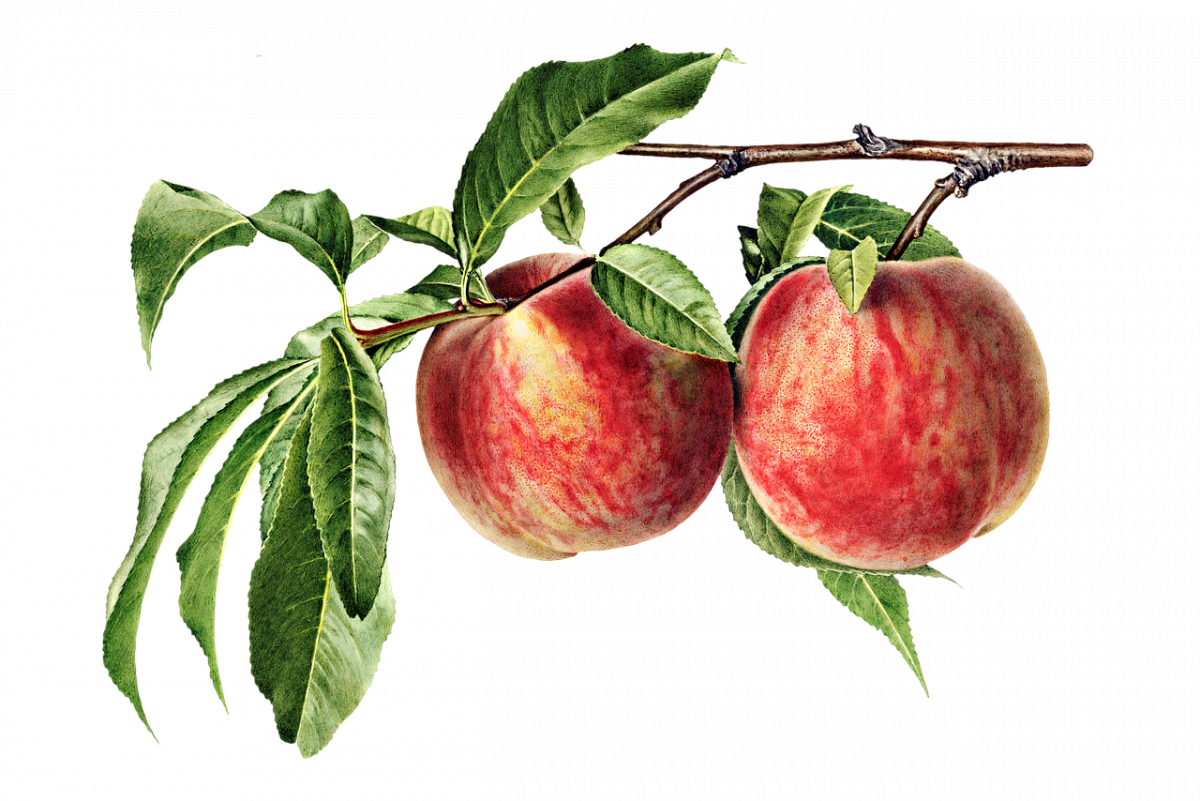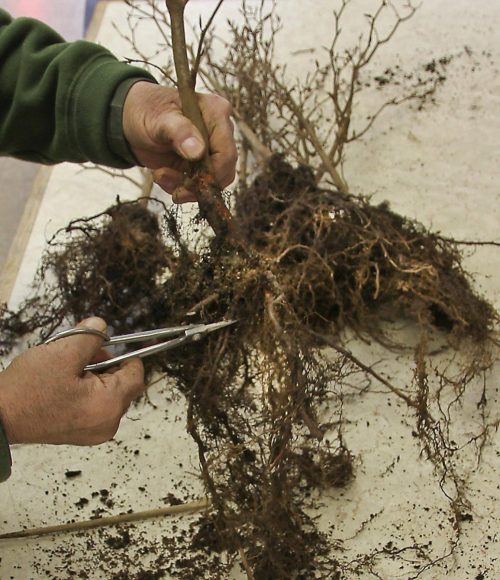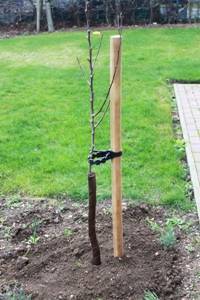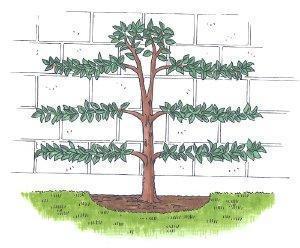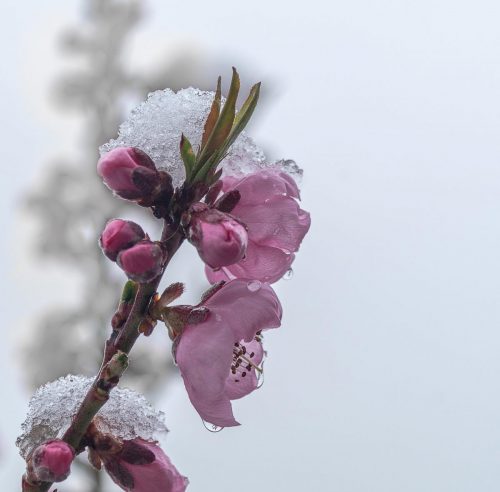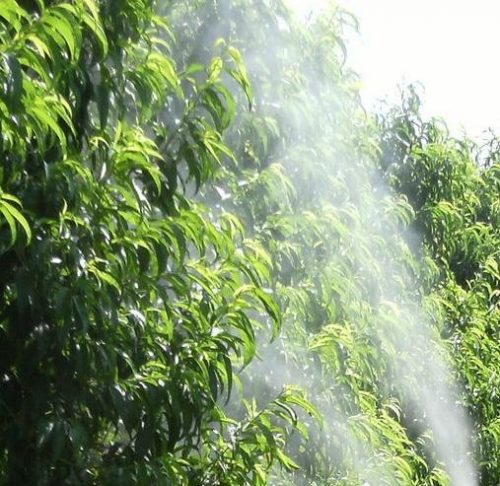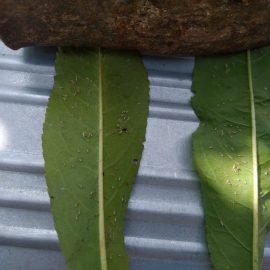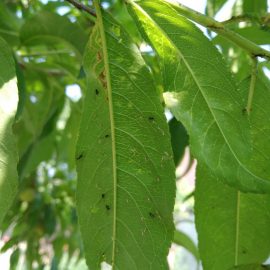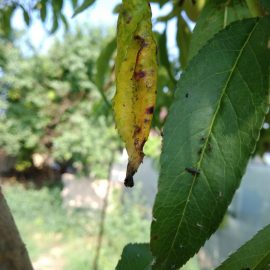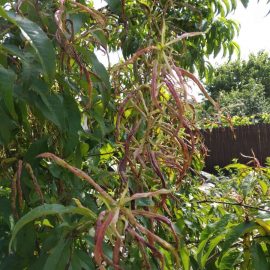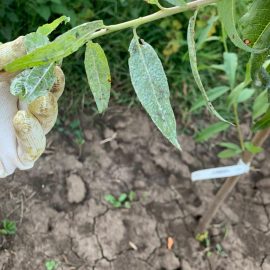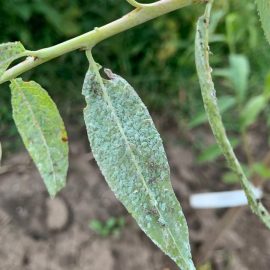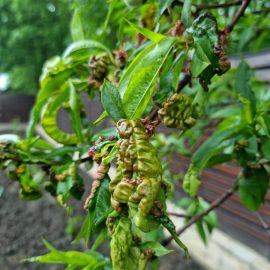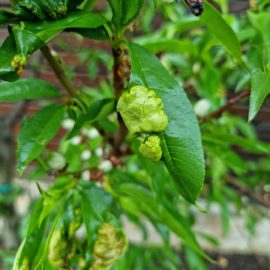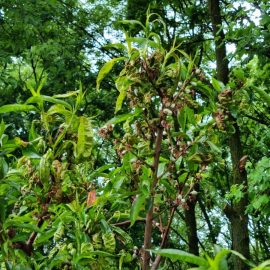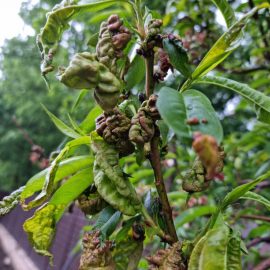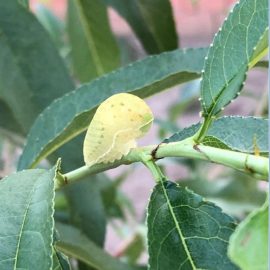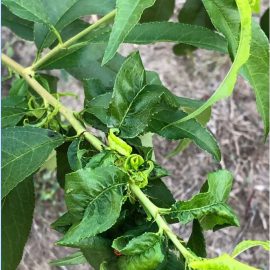Peach tree, planting, growing and harvesting
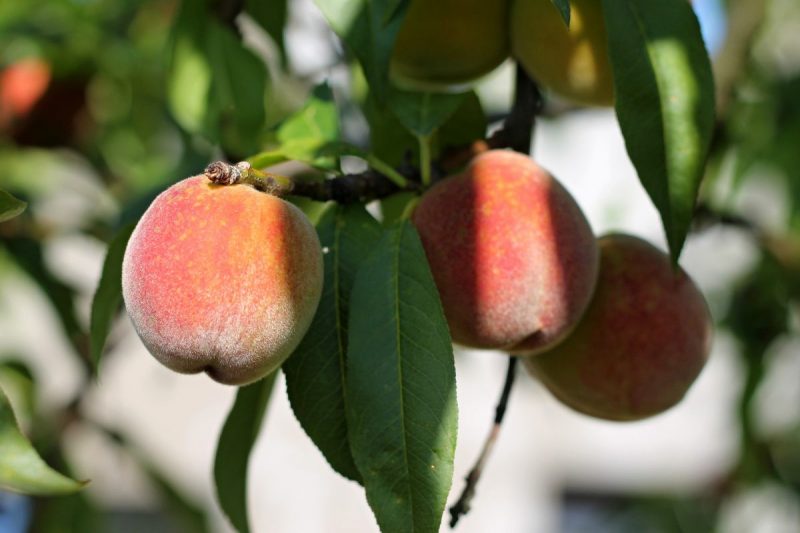
The peach tree (Prunus persica) is a fruit tree native to China, with high demands on heat, being affected by late frosts. Despite this, the production can be constant for 10-15 years. The leaves are lance-shaped and the flowers are small, solitary, and of various colors (pinkish-white). The peach fruit is a globular drupe with a fine, fragrant, and juicy pulp. Peaches have a high nutritional value and contain sugars, proteins, vitamins (B1, B2, B6, A, E), potassium, phosphorus, calcium, sodium, zinc, iron, and copper.
Growing and fruiting particularities
The peach tree forms a very rich root system. Most of the roots penetrate to a depth of 20-60 cm, and a few to 3-4 m, but, regardless of the planting density, the roots do not intertwine. They grow intensely in spring and autumn when the soil temperature is 8-20 °C.
The aerial part of the peach tree grows rapidly in the first years of vegetation. It emits 1-3 series of anticipated shoots that agglomerate the crown, and at maturity, it reaches a height of 3-4 m. Flowering takes place in April-May, depending on the climatic conditions, the average temperatures required are at least 10 °C. To ensure high yields, it is recommended to place several varieties in the plot.
If, before fruit ripening, the soil moisture is high, in the case of some varieties, especially those with extra-early and early ripening, the endocarp cracks. This phenomenon occurs due to the brief hydration of the pulp.
After fruiting, the intensity of vegetative growth decreases. Peach bears good fruit 2-3 years after planting, being an early species. It bears fruit annually, without being affected by fruiting alternation.
Climate and soil requirements
Peach is a species with high heat requirements. It grows and develops in areas with an average annual temperature of 10-11.5 °C. During winter it can withstand temperatures of -24 °C. The buds withstand temperatures of -3.9 °C, and the flowers abort at temperatures below -3 °C.
Peach is resistant to prolonged drought, but for high yields, water becomes a limiting factor. In the absence of water, peach fruits remain small and flattened, and production is reduced both in quality and quantity. It reacts well to irrigation, especially in the period before fruit ripening, thus obtaining significant yield increases.
Excess water in the soil, even for short periods, is harmful to the peach tree, causing root suffocation. High humidity in the air favors the onset of diseases and winter fog amplifies the negative effects of frost.
It has high light requirements, so to make good use of solar radiation, pruning must ensure good ventilation of the crown and the orchard should be located only on slopes with southern exposure. In the absence of light, the leaves grow poorly, the trees are sensitive to frost and production is poor in terms of quantity or quality.
Soil preparation
Peach trees should be planted on fertile, permeable, medium, sandy, loamy-sandy soils. If the land is sloping, the trees should be planted only on the upper part and the rows should be oriented north-south (these locations reduce losses due to late frosts). Soil preparation can be done according to the general rules. If the plantation is established on land that has been used as an orchard, the land should be prepared 1-2 years in advance. To restore the soil structure and eliminate infection outbreaks, the land can be cultivated with perennial grasses. If the plot is heavily infested with weeds, you can apply non-selective herbicides.
Recommended products
-
You can find products on a different store
Change Store -
You can find products on a different store
Change Store -
You can find products on a different store
Change Store -
You can find products on a different store
Change Store -
You can find products on a different store
Change Store -
You can find products on a different store
Change Store -
You can find products on a different store
Change Store -
You can find products on a different store
Change Store -
You can find products on a different store
Change Store -
You can find products on a different store
Change Store -
You can find products on a different store
Change Store -
You can find products on a different store
Change Store -
You can find products on a different store
Change Store -
You can find products on a different store
Change Store -
You can find products on a different store
Change Store -
You can find products on a different store
Change Store -
You can find products on a different store
Change Store -
You can find products on a different store
Change Store -
You can find products on a different store
Change Store -
You can find products on a different store
Change Store -
You can find products on a different store
Change Store -
You can find products on a different store
Change Store -
You can find products on a different store
Change Store -
You can find products on a different store
Change Store
The soil can be fertilized with organic fertilizers (manure, compost). It is recommended to scarify the soil so that the roots grow easily. All foreign matter in the soil should be collected and removed from the plot, after which the land must be well-leveled.
For precise planting, the land can be picketed. Picketing is the process of marking the position of each peach tree on the ground. Specifically, a stake is inserted into the tree planting site.
Planting
The optimum planting time for most fruit species is in autumn. This rule also applies to peaches. The planting material must be procured only from authorized nurseries or orchards. The following planting scheme is recommended: 5 × 4 m for the classic culture system and 4×2 m for the intensive system.
Root trimming
Before planting, the roots can be trimmed. The operation is performed to remove the damaged portions and to maintain a healthy root system. The necrotic roots must be completely removed, and the healthy ones must be shortened by 7-8 cm. Root pruning should only be carried out if the root material has recently been removed from the soil.
After trimming, the roots can be soaked. Mudding means dipping the root into a mixture of yellow soil, fresh manure, and water. The mud layer helps the tree to adapt to the new soil conditions and maintains the moisture around the roots.
Actual planting
This stage begins by digging the pit. If the soil has not been worked, the pit must be dug 2-3 months before and have the following dimensions: 100 x 100 x 80 cm. If the soil has been worked properly, the pit must be dug 1-2 days before or even on the same day. In this case, the pit will have the following dimensions: 50 x 50 x 50 cm. At the base of the pit, you can introduce a mixture of fertile soil removed from the topside of the pit and well-decomposed manure.
Insert the tree into the pit so that the root stays on the fertile layer at the base. After the roots have been covered with 10 cm of soil, carry out the first soil tamping. When planting, the roots must be in close contact with the soil. The planting depth is calculated so that the grafting point is 3 cm above the ground and facing north. After planting, insert a stake next to the tree. The tree can be covered with rodent protection materials.
Care works
In the spring, the trees need water. Irrigation is necessary to ensure their survival. Around the trees, the soil can be dug superficially or can be covered with plant debris (mulch). Mulching maintains a good phytosanitary condition, prevents the development of weeds, conserves water in the soil, and reduces the number of maintenance works.
Peach tree pruning
In the first spring, the tree can be shortened to 80 cm. After the tree has started growing, all twigs up to a height of 50 cm should be removed. From the upper part of the tree, pick 3-4 twigs evenly arranged on the tree to form the first layer of the crown. The rest of the twigs should be removed from the plant.
In the second year of growth, the selected twigs should be shortened to 50 cm above an outward-facing bud. The branch extending the axis should be 25 cm higher than the first layer of the crown. This can be corrected by a cut above an outer bud. On the 3-4 main branches leave 2-3 extension twigs. Remove the rest of the growth.
The cuts should be made above an outward-facing bud. On the central axis, choose 3-4 twigs evenly arranged on the tree to form a new layer. Remove competing branches and branches that shade each other. The remaining branches on the axis should be shortened to 10-15 cm to fruit. In summer, remove water sprouts, competing branches, and those on the upper part of the main branches.
In the fourth year, the twigs chosen to form the new crown layer should be shortened so that they stand 20-25 cm higher than the first layer. This is how the peach crown is formed. After four years of severe pruning, the tree starts to fruit well. From this point on, pruning will maintain the shape of the crown and regulate the fruit load. During this period pruning means removing water sprouts, dry or diseased branches and maintaining a balance between growth and fruiting.
Recommended products
-
You can find products on a different store
Change Store -
You can find products on a different store
Change Store -
You can find products on a different store
Change Store -
You can find products on a different store
Change Store -
You can find products on a different store
Change Store -
You can find products on a different store
Change Store -
You can find products on a different store
Change Store -
You can find products on a different store
Change Store -
You can find products on a different store
Change Store -
You can find products on a different store
Change Store -
You can find products on a different store
Change Store -
You can find products on a different store
Change Store -
You can find products on a different store
Change Store -
You can find products on a different store
Change Store -
You can find products on a different store
Change Store -
You can find products on a different store
Change Store -
You can find products on a different store
Change Store -
You can find products on a different store
Change Store -
You can find products on a different store
Change Store -
You can find products on a different store
Change Store -
You can find products on a different store
Change Store -
You can find products on a different store
Change Store -
You can find products on a different store
Change Store -
You can find products on a different store
Change Store
Summer pruning
Summer pruning can be more easily tolerated by the peach tree because of its ability to regenerate. During this period, remove water sprouts and cross branches. Remove the tips of young twigs. This operation leads to the development of buds below the pruning spot. All cuts should be made at an angle of 45 degrees and wounds larger than 2 cm should be covered with tree wound sealer. In this way, water will easily drain from the wound.
Recommended products
-
You can find products on a different store
Change Store -
You can find products on a different store
Change Store -
You can find products on a different store
Change Store -
You can find products on a different store
Change Store -
You can find products on a different store
Change Store -
You can find products on a different store
Change Store -
You can find products on a different store
Change Store -
You can find products on a different store
Change Store -
You can find products on a different store
Change Store -
You can find products on a different store
Change Store -
You can find products on a different store
Change Store -
You can find products on a different store
Change Store -
You can find products on a different store
Change Store -
You can find products on a different store
Change Store -
You can find products on a different store
Change Store -
You can find products on a different store
Change Store -
You can find products on a different store
Change Store -
You can find products on a different store
Change Store -
You can find products on a different store
Change Store -
You can find products on a different store
Change Store -
You can find products on a different store
Change Store -
You can find products on a different store
Change Store -
You can find products on a different store
Change Store -
You can find products on a different store
Change Store
Growing and fruiting stimulation
These operations stimulate the peach tree to produce more fruit, to bear fruit faster, or to develop stronger twigs:
- Branch training: represents the change of natural position of the branches, towards the vertical. This causes the branch to grow and strengthen. This operation should carried out mainly in the mature phase of the trees. In this phase, the vegetative growth ceases and this operation leads to the rejuvenation of the tree crown.
- Branch tying down: it consists in changing the position of the branches, towards the horizontal. This causes the buds on the branch to differentiate and aerates the crown. Branches can be tied down below the horizontal to obtain abundant fruiting. This operation is practiced in the young stage of the trees when vegetative growth is predominant.
- Branch arching: through this change of position, the basal part remains ascending, and the terminal part is inclined below the horizontal (descent). This operation stops or slows down the growth in length of the branch and promotes bud growth. Trees that have been arched begin to bear fruit 2-3 years earlier.
The peach tree is pretentious about soil. In this case, it is recommended to till or cultivate the soil in the orchard with perennial grasses. Under irrigation conditions, fruit plants or fruit bushes can be grown on the interval between rows. Examples: tomatoes, peppers, eggplant, onions, garlic, potatoes. Herbicides can also be applied, but only after 2-3 years from planting.
Recommended products
-
You can find products on a different store
Change Store -
You can find products on a different store
Change Store -
You can find products on a different store
Change Store -
You can find products on a different store
Change Store -
You can find products on a different store
Change Store -
You can find products on a different store
Change Store -
You can find products on a different store
Change Store -
You can find products on a different store
Change Store -
You can find products on a different store
Change Store -
You can find products on a different store
Change Store -
You can find products on a different store
Change Store -
You can find products on a different store
Change Store -
You can find products on a different store
Change Store -
You can find products on a different store
Change Store -
You can find products on a different store
Change Store -
You can find products on a different store
Change Store -
You can find products on a different store
Change Store -
You can find products on a different store
Change Store -
You can find products on a different store
Change Store -
You can find products on a different store
Change Store -
You can find products on a different store
Change Store -
You can find products on a different store
Change Store -
You can find products on a different store
Change Store -
You can find products on a different store
Change Store
Protecting peach tree from frost
Due to the unstable weather conditions, fruit trees are often affected by late spring frosts. They can compromise the harvest, so to protect the trees, you may consider the fumigation technique. When low temperatures are announced, in the orchard, you can burn easily burning materials (gathered in piles), which produces a large amount of smoke (rubber, straw, manure, tar, peat, etc.). Thus, the smoke layer that forms above the orchard does not allow heat to be released from the soil and thus maintains a higher temperature at the trunk/tree crown level. It is very important to keep the fire on throughout the night, especially before sunrise, when temperatures drop sharply. This operation can protect the trees from temperatures down to -3 °C.
Fertilization
Because it is a very productive species, peach needs extra fertilization. Besides macroelements, the tree also consumes iron, boron, zinc, magnesium, etc. For young orchards it is recommended to apply manure as well as NPK complex fertilizer. To ensure the necessary microelements, you cand apply foliar fertilisation.
Recommended products
-
You can find products on a different store
Change Store -
You can find products on a different store
Change Store -
You can find products on a different store
Change Store -
You can find products on a different store
Change Store -
You can find products on a different store
Change Store -
You can find products on a different store
Change Store -
You can find products on a different store
Change Store -
You can find products on a different store
Change Store -
You can find products on a different store
Change Store -
You can find products on a different store
Change Store -
You can find products on a different store
Change Store -
You can find products on a different store
Change Store -
You can find products on a different store
Change Store -
You can find products on a different store
Change Store -
You can find products on a different store
Change Store -
You can find products on a different store
Change Store -
You can find products on a different store
Change Store -
You can find products on a different store
Change Store -
You can find products on a different store
Change Store -
You can find products on a different store
Change Store -
You can find products on a different store
Change Store -
You can find products on a different store
Change Store -
You can find products on a different store
Change Store -
You can find products on a different store
Change Store
Irrigation
To reach the maximum yield potential it is necessary to irrigate the peach plantation. By watering the trees in the fruit’s early ripening phase, you can increase production by 25 %. Depending on the climatic conditions, you can apply 4-5 irrigations with a norm of 400-600 cubic metres/ha.
Fruit thinning
Having a very high fertility, the peach tree forms more fruit than it can sustain and feed. To avoid its splitting, the tree requires fruit thinning. The operation should be carried out at the end of June and must be completed before the endocarp hardens. Ensure a distance of 8-10 and 15-20 cm between fruit on the branches. Deformed and abnormally developed peaches should also be removed.
Pests and diseases control
Orchard’s phytosanitary condition is very important. Carrying out phytosanitary treatments according to the specific calendar for peaches can significantly reduce the occurrence of diseases and pests. To destroy outbreaks of infection in the orchard, apply treatments during the dormant period (winter). Treatments should be applied in winter windows when the temperature is above 5 °C.
Against diseases, the first treatment (after leaf fall) should be done with copper-based products. The second spraying with copper-based products must be done in spring, at bud break. The solution should be sprayed all over the tree, from the base of the tree to the branches. These treatments need to be applied on days without rainfall, with temperatures above 6-7° C, so the solution does not freeze on the trees.
Recommended products
-
You can find products on a different store
Change Store -
You can find products on a different store
Change Store -
You can find products on a different store
Change Store -
You can find products on a different store
Change Store -
You can find products on a different store
Change Store -
You can find products on a different store
Change Store -
You can find products on a different store
Change Store -
You can find products on a different store
Change Store -
You can find products on a different store
Change Store -
You can find products on a different store
Change Store -
You can find products on a different store
Change Store -
You can find products on a different store
Change Store -
You can find products on a different store
Change Store -
You can find products on a different store
Change Store -
You can find products on a different store
Change Store -
You can find products on a different store
Change Store -
You can find products on a different store
Change Store -
You can find products on a different store
Change Store -
You can find products on a different store
Change Store -
You can find products on a different store
Change Store -
You can find products on a different store
Change Store -
You can find products on a different store
Change Store -
You can find products on a different store
Change Store -
You can find products on a different store
Change Store
7-10 days after applying the copper treatments, can be applied horticultural oil, which acts against pests that may overwinter in the tree bark.
Recommended products
-
You can find products on a different store
Change Store -
You can find products on a different store
Change Store -
You can find products on a different store
Change Store -
You can find products on a different store
Change Store -
You can find products on a different store
Change Store -
You can find products on a different store
Change Store -
You can find products on a different store
Change Store -
You can find products on a different store
Change Store -
You can find products on a different store
Change Store -
You can find products on a different store
Change Store -
You can find products on a different store
Change Store -
You can find products on a different store
Change Store -
You can find products on a different store
Change Store -
You can find products on a different store
Change Store -
You can find products on a different store
Change Store -
You can find products on a different store
Change Store -
You can find products on a different store
Change Store -
You can find products on a different store
Change Store -
You can find products on a different store
Change Store -
You can find products on a different store
Change Store -
You can find products on a different store
Change Store -
You can find products on a different store
Change Store -
You can find products on a different store
Change Store -
You can find products on a different store
Change Store
Harvesting
The fruit ripens in stages. Because of this, harvesting usually involves 2-3 passes. The peaches have the ability to post ripen, so harvesting can be done before consumption maturity. In general, the fruit is harvested when it has reached the size and colour specific to the variety and the flesh is still firm. Peaches can be stored in cold storage for 2-3 weeks. Harvesting should take place in dry and cool weather.














































































































































































































































































































































































































































